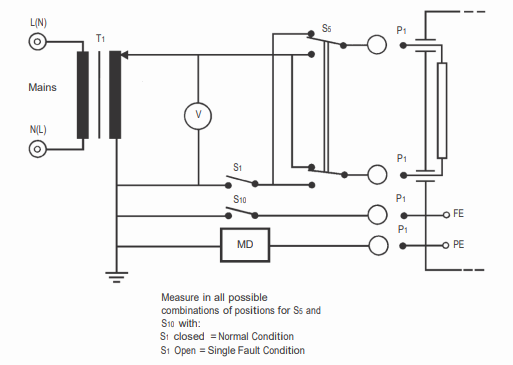Keeping patients safe is critical in medical device design. For electrical medical devices, one of the most important aspects of this is eliminating shock hazard. As leakage current is the primary source of shock hazard, low leakage levels are crucial and the main difference between a medical-grade power supply and a commercial-grade one. We’ll talk about leakage current requirements for medical power supplies and how they’re different from commercial power supplies.
What is the maximum allowable leakage current for a medical power supply?
Leakage current requirements for medical devices, and their subsequent power supplies, depend on a number of factors.
Location of Use
The standards that apply to a medical device depend on the geographical locations it will be used in (and more than one standard may apply). One of the most widely used standard is the EN 60601-1. EN 60601-1 is a body of safety standards regarding Medical Electrical Equipment that is recognized by the United States, Canada, EU, and other countries. Among the 60601-1 standards set by the International Electrotechnical Commission are stringent limits on allowable leakage current in medical electrical equipment, under set test conditions.
Medical Device Classification
According to the 60601-1 standards, PC-based power supplies are categorized as a component of a movable or stationary device. Due to their method of electrical insulation, they are categorized as Class I, which must have both sufficient insulation and a protective earth ground to protect against electric shock.
Contact with Patients
Maximum leakage current for a medical device is determined by the end application – that is, whether the device is connected to a patient or not using an Applied Part, and if so, how it is connected. An Applied Part is the part of the medical electrical equipment that necessarily comes that comes into contact with the patient (like an ECG lead). Equipment with Type B (body) Applied Parts are designed to operate within a patient’s vicinity without making direct electrical contact (MRI scanners, or X-ray machines, for example). Type BF (body floating) Applied Parts are designed to make direct contact (like blood pressure monitors or ultrasound). Type CF (cardiac floating) Applied Parts are designed to make contact with the heart (like defibrillators).
Power supplies should never be in direct contact with the patient but could be connected to accessories that are. Any accessories connected to patient-connected devices (including PCs) are held to the same leakage current safety standards as the medical device itself.
Type of Leakage Current
Power supplies have earth leakage current and touch leakage current.
Test Conditions
Allowable leakage current limits vary under certain conditions, which are determined by the specified testing methods. The two types test conditions are in the Normal Condition (NC) and Single-Fault Condition (SFC).
Leakage current standards for medical and commercial power supplies
| Medical Power Supply | |||
| Standard | Leakage Location | Test Condition (264 Vac, 60 Hz) | Maximum Current |
| EN 60601-1 for Class I device | Earth* | NC | 5 mA |
| EN 60601-1 for Class I device | Earth* | SFC | 10 mA |
| EN 60601-1 for Class I device | Touch | NC | 100 uA |
| EN 60601-1 for Class I device | Touch | SFC | 500 uA |
| Commercial Power Supply | |||
| EN 62368-1 for PC power supplies | Earth | NC | 10 mA |
| EN 62368-1 for PC power supplies | Earth | SFC | 20 mA |
| EN 62368-1 for PC power supplies | Touch | NC | 100 uA |
| EN 62368-1 for PC power supplies | Touch | SFC | 3,500 uA |
* For permanently installed medical electrical equipment connected to a supply current that supplies only that medical electrical equipment, a higher value of earth current is allowed.
As you can see from the chart, non-medical-grade power supply standards allow for seven times as much touch leakage current in single-fault condition as for a medical-grade power supply.
Design for Safety
Low leakage current in the power supply is a crucial part of medical device design. At the same time, EMI mitigation must be factored in. For a safe and compliant design, always choose a medical supply for your device.
(Leakage Current in Medical Devices, Leakage Current in Power Supplies, Leakage Current Requirements for Medical Power Supplies)
________________________
RAM medical power supplies’ touch leakage current typically measures 230 uA, at 264 Vac, 60Hz – roughly eight times less than the typical non-medical power supply. Contact us for details.
